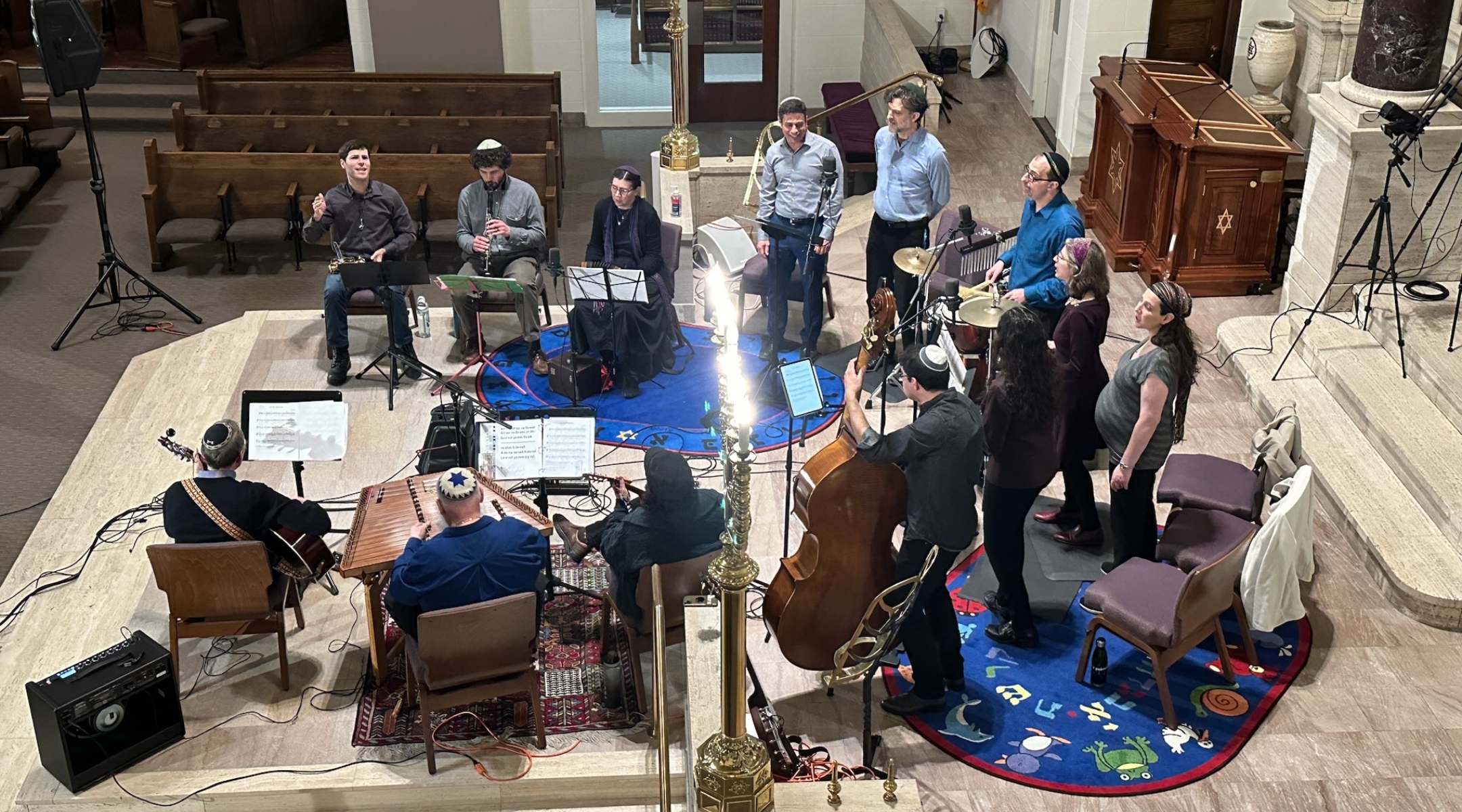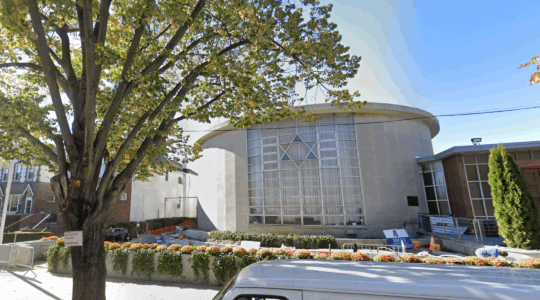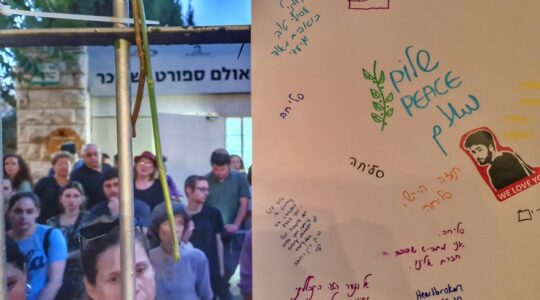(JTA) — On Nov. 29, 2021, Ilan and Sherri Glazer announced to the public that they were expecting a baby after three rounds of IVF.
The following day, during their 20-week ultrasound, they learned that their baby’s brain wasn’t forming properly. Multiple scans and visits with other doctors confirmed that their long-awaited baby’s condition was not compatible with a good quality of life, and the couple made the difficult decision to terminate at 26 weeks.
They named the baby Shemaryah, meaning “God watches over.” The name comes from Psalm 121, which the couple sang every night during the pregnancy before going to sleep. They continued singing the psalm following the 20-week checkup, and sang it once more at Shemaryah’s funeral.
Two years later, Ilan Glazer, a rabbi and musician, is releasing an album inspired by his family’s experience, with lyrics drawn from Jewish liturgy, including poems and psalms. The melodies came to him throughout the IVF process, while most of the words emerged as he and Sherri grieved the loss of their son.
Now, Ilan hopes his album, “Gam Ki Elech: Turning Our Sorrows Into Songs,” might provide solace to others in cases where Jewish liturgy, law and custom are limited in what they can provide for parents experiencing the early loss of a child.
Glazer said it was particularly painful that the local Jewish burial society declined to wash Shemaryah’s body following his death — a ritual known as tahara — because he was less than 30 days old. Jewish law does not require traditional mourning or burial practices for a baby who lived fewer than 30 days.
Instead, the Glazers spent the Shabbat following the stillbirth ritually preparing Shemaryah’s body for burial with assistance from friends.
“The worst thing that you can tell a family just after a loved one has died is, ‘We’re not going to help you,’” Ilan said. “And that was especially jarring.”
He added, “Grief over child loss is not widely discussed in the Jewish community.”
“One of the hardest parts of stillbirth,” said Rabbi Idit Solomon, CEO of Hasidah, a group that provides grants and support for Jewish families undergoing IVF, is that “we have advanced emotionally and societally and the Jewish community is still kind of religiously immature and theologically immature.”
Historians and anthropologists say there is a compassionate — and also pragmatic — motivation behind a tradition that does not mourn stillbirth and miscarriage with the rigorous rituals applied to the death of an older child or adult.
“Until the 20th century, you had very high infant mortality rates,” said Michal Raucher, associate professor of Jewish Studies at Rutgers University. “If we instituted all of the mourning rituals that we have for a child or an adult for every miscarriage and stillbirth, for every infant that died in the first couple of weeks of life, people would be in mourning all the time.”
The decline in infant mortality and other advances in neonatology have led families to seek new rituals. While saying the Mourner’s Kaddish for a stillborn baby might be rare, Raucher says in recent years she has seen more informal and online communities emerge to connect members of the Jewish community who have experienced stillbirth and miscarriages. Community members are typically willing to bring a meal to the house of a family mourning a stillbirth or a late miscarriage, replicating “some of the ways that the Jewish community supports people who have experienced loss,” Raucher said.
In 1998, a “grieving ritual following miscarriage or stillbirth” was included in “Lifecycles,” a landmark book of new Jewish rituals created by and for Jewish women. In her 2007 study “Inventing Jewish Rituals,” religion scholar Vanessa Ochs writes that new rites developed since the 1970s surrounding miscarriage, stillbirths, infertility and abortion “mark events linked to women’s bodily experiences that previously have not evoked formal Jewish responses.”
When the Glazers opened up to their rabbi, it led him to discuss the subject from the synagogue pulpit, recounting in sermons how the mothers in the early Genesis stories dealt with their own challenges in conceiving, Sherri Glazer said.
But, she said, “it doesn’t help that those same Bible stories that talk about women struggling end with the women ultimately having kids.”
“The Jewish community can definitely do better,” she added. “I think that’s why we’re speaking out. This is our experience. This is who we are.”
In addition to choosing their own Jewish mourning rituals, Sherri Glazer created a mosaic, the concept for the design appearing to her in something like a vision.
“I kept having this imagery show up in my dreams of Shemaryah in the clouds, of him playing ball, of him being a kid,” she told JTA. “And that image really stuck with me. It showed up more than once.”
On Shemaryah’s first yahrzeit, the anniversary of his death, she hung up the mosaic behind the family’s Shabbat candles. The commandment to “keep” and “remember” the Sabbath, shamor v’zachor — corresponding with the Shabbat candles — shares a root with Shemaryah’s name.
On Friday nights, the Glazers say the blessing for the children to connect with Shemaryah, even though he’s not there.
“He’s very much part of our ritual lives,” Sherri said.
Acknowledging the loss publicly, both parents say, has been crucial to their grieving process, and made it clear to their community members this is not something they would keep silent about — especially since so much of Jewish community life is predicated on childrearing.
After they announced the death of their son, multiple Jewish couples reached out to the Glazers saying they had also experienced a miscarriage or stillbirth or pregnancy termination, and they created a Facebook group for this community.
“We decided that, not entirely for selfish purposes, but we needed to hear from other couples about how they had gone through it, because there was so little material out there for us from a Jewish perspective,” Ilan Glazer said. “Obviously, everybody’s story is a little bit different, but how do you go forward? How do you talk about the death of one child to another child? How do you mark the anniversary of a death? There are things that only those who have faced this have to think about and it’s been very meaningful to have that place.”
In addition to the Facebook group and their synagogue community, the Glazers hope to have plenty of opportunity to discuss what family looks like after loss. Sherri is pregnant again, due in March. (The couple chose embryo donation after learning that Ilan has a mild version of the same syndrome that caused Shemaryah’s brain condition and could pass it on to another child.)
“It’s even harder to plan for a new baby after having a loss like we had. Until this baby is actually here in our arms, it’s really hard to really even envision them being here,” Sherri said. “It is clear to both of us that we want them to know about Shemaryah, that Shemaryah will always be their big brother.”
Much like with their rounds of IVF and as with Shemaryah, music and Jewish ritual played a big role in this pregnancy.
Sherri and Ilan went to the mikveh, or ritual bath, before the embryo transfer, and for Jewish inspiration consulted a fertility guide from Mayyim Hayyim, a Boston-based mikveh and spirituality center. It was there that Sherri found a verse in English that she wanted as their next song.
While the song won’t be on the 13-track album, Ilan performed it at the close of the album release show two weeks ago at Beth Am Baltimore, the Conservative synagogue where he and Sherri are members.
“I want this to be a healing experience,” Ilan, who is also an addiction recovery coach, said. “Every time I share these melodies with others, people tell me that it allows them to process grief that they’ve been carrying, in some cases, for many years. And I’m truly honored by that.”
JTA has documented Jewish history in real-time for over a century. Keep our journalism strong by joining us in supporting independent, award-winning reporting.






